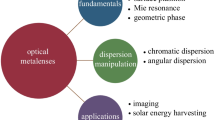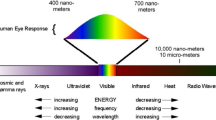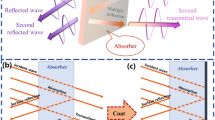Abstract
The optical response of a metal-dielectric multilayer structure consisting of a hybrid Au/Ag grating and an adhesive layer sandwiched between two dielectric layers has been analyzed using the Finite Difference Frequency Domain (FDFD) method. We observed two surface plasmon resonance (SPR) modes, one in the visible and the other in the ultraviolet region due to the localization of the field at the dielectric-metal interface. Among the other well-known attributes that affects the SPR characteristics, the structural and optical properties of the adhesive layer are crucial in determining the SPR peak/dip intensity profile even though the SPR wavelength is relatively unchanged. Hence, we show a direct application of FDFD numerical analysis of the multimode SPR dependence on the adhesive layer properties in dielectric-metal-grating-dielectric layers, which is useful for more precise experimental fabrication of optical sensors.












Similar content being viewed by others
Data availability
Not applicable.
References
Arcub, O.A., Hamour, Z.A., Al-Badarneh, R., Momani, S.: A reliable analytical method for solving higher-order initialvalue problems. Discret. Dyn. Nat. Soc. 2013, 1–13 (2013). https://doi.org/10.1155/2013/673829
Batista, C.G., Rego, C.G.: Application of the finite-difference frequency-domain (FDFD) method on radiowave propagation in urban environments. J. Microw. Optoelectron. Electromagn. Appl. 17(3), 373–384 (2018). https://doi.org/10.1590/2179-10742018v17i31318
Berenger, J.P.: A perfectly matched layer for the absorption of electromagnetic waves. J. Comput. Phys. 114(2), 185–200 (1994). https://doi.org/10.1006/jcph.1994.1159
Bilal, R.M.A., Baqir, M.A., Hameed, M., Naqvi, S.A., Ali, M.A.: Triangular metallic ring-shaped broadband polarization-insensitive and wide-angle metamaterial absorber for visible regime. J. Opt. Soc. Am. A. 39, 136–142 (2022). https://doi.org/10.1364/JOSAA.444523
Boyd, G.D., Buehler, E., Storz, F.G., Wernick, J.H.: Linier and Nonlinier optica properties of ternary AIIBIVC2V chalcopyrite semiconductors. IEEE J. Quant. Electron. 8(4), 419–426 (1972). https://doi.org/10.1109/QE.1972.1076982
Chou, C.F., Tsai, C.M., Chen, C.H., Wong, Y.H., Fang, Y.C., Wen, C.C., Lee, H.Y., Le, H.T., Chang, S.H., Liao, H.Y.: Optical design and optimization with genetic algorithm for high-resolution optics applied to underwater remote-sensing. Appl. Sc. 11(21), 1–22 (2021). https://doi.org/10.3390/app112110200
Cozza, D., Ruiz, C.M., Duche, D., Giraldo, S., Saucedo, E., Simon, J.J., Escoubas, L.: Optical modeling and optimizations of Cu2ZnSnSe4 solar cells using the modified transfer matrix method. Opt. Express. 24(18), 1201–1209 (2016). https://doi.org/10.1364/OE.24.0A1201
Esmailidastjerdipour, P., Shahshahani, F.: Numerical simulation of surface plasmons resonance optical fiber biosensor enhanced by using alloy for medical application. Sens. Imag. 24(1), 1–19 (2023). https://doi.org/10.1007/s11220-022-00409-y
Fard, S.T., Donzella, V., Schmid, S.A., Flueckiger, J., Grist, S.M., Fard, P.T., Wu, Y., Bojko, R.J., Kwok, E., Jaeger, N.A.F., Ratner, D.M., Chrostowski, L.: Performance of ultra-thin SOI-based resonators for sensing applications. Opt. Express 22(12), 14166–14179 (2014). https://doi.org/10.1364/OE.22.014166
Fujii, Y., Sakudo, T.: Dielectric and optical properties of KTaO3. J. Phys. Soc. Jpn. 41(3), 888–893 (1976). https://doi.org/10.1143/JPSJ.41.888
Ghaemi, H.F., Thio, T., Grupp, D.E., Ebbesen, T.W., Lezec, H.J.: Surface plasmons enhance optical transmission trough subwavelength holes. Phys. Rev. B 58(11), 6779–6782 (1998). https://doi.org/10.1103/PhysRevB.58.6779
Insana, D., Rappaport, C.M.: Using FDFD technique in two-dimanesional TE analysis for modeling clutter in wall penetrating radar. Int. J. Antennas Propagat. 2014, 1–10 (2014). https://doi.org/10.1155/2014/274063
Irannejad, M., Cui, B.: Effects of refractive index variations on the optical transmittance spectral properties of the nano-hole arrays. Plasmonics 8(1), 1–7 (2013). https://doi.org/10.1007/s11468-013-9540-z
Issaacs, S., Hajoj, A., Abutoama, M., Kozlovsky, A., Golan, E., Abdulhalim, I.: Resonant grating without a planar waveguide layer as a reractive index sensor. Sensors 19(13), 1–13 (2019). https://doi.org/10.3390/s19133003
Jana, J., Ganguly, M., Pal, T.: Enlightening surface plasmon resonance effect of metal nanoparticles for practical spectroscopic application. RSC Adv. 6(89), 1–36 (2016). https://doi.org/10.1039/C6RA14173K
Johnson, P.B., Christy, R.W.: Optical constant of transition metals: Ti, V, Cr, Mn, Fe, Co, Ni, Pd. Phys. Rev. B. 9(12), 5056–5070 (1974). https://doi.org/10.1103/PhysRevB.9.5056
Liang, S., Xu, F., Yang, H., Cheng, S., Yang, W., Yi, Z., Song, Q., Wu, P., Chen, J., Tang, C.: Ultra long infrared metamaterial absorber with high absorption and broad band based on nano cross surrounding. Opt Laser Technol. 158, 108789 (2023). https://doi.org/10.1016/j.optlastec.2022.108789
Marhic, M.E., Rieznik, A.A., Kalogerakis, G., Braimiotis, C., Fragnito, H.L., Kazovsky, L.G.: Accurate numerical simulation of short fiber optical parametric amplifiers. Opt. Epress. 16(6), 3610–3622 (2008). https://doi.org/10.1364/OE.16.003610
Mathewson, A.G., Myers, H.P.: Absolute values of the optical constants of some pure metals. Phys. Scripta. 4(6), 291–292 (1971). https://doi.org/10.1088/0031-8949/4/6/009
Palik, E.D.: Handbook of optical constants of solids. Academic Press, America Serikat (1991)
Park, S.Y., Kim, H., Song, B.S.: Design of thin-film photonic crystals with complete photonic bandgap. Opt. Express 25(22), 29521–29528 (2018). https://doi.org/10.1364/OE.26.029521
Putra, A.S., Sismanto, S.: Numerical simulation of maxwell equation using finite difference method in case of subsurface conductivity parameter. J. Inovasi Penelitian dan PembelajaranFisika. 3(2), 59–66 (2022). https://doi.org/10.26418/jippf.v3i2.55820
Rumpf, R.C.: Simple implementation of arbitrarily shaped total-feld/scattered-feld regions in finite-difference frequency-domain. Prog. Electromagn. Res. B. 36(36), 221–248 (2012). https://doi.org/10.2528/PIERB11092006
Rumpf, R.C., Garcia, C.R., Berry, E., Barton, J.H.: Finite-difference frequency-domain algorithm for modeling electromagnetic scattering from general anisotropic objects. Prog. Electromagn. Res. B. 61(1), 55–67 (2014). https://doi.org/10.2528/PIERB14071606
Starke, R., Wirnata, R., Schober, G.A.H., Bulut, N., Kortus, J.: Wavevector-dependent optical properties from wavevector-independent proper conductivity tensor. European Phys. J. B. 93(54), 1–14 (2020). https://doi.org/10.1140/epjb/e2019-90569-0
Suherman, A.M., Negara, T.P., Hardhienata, H., Alatas, H.: Simulasi Perambatan Gelombang Elektromagnetik pada Krista Fotonik 2D Menggunakan Metode Finite Difference Frequency Domain. Komputasi 16(2), 255–262 (2019). https://doi.org/10.33751/komputasi.v16i2.1619
Sun, F., Ge, X., He, S.: Creating a zero-order resonator using an optical surface transformation. Sci. Rep. 6(1), 1–4 (2015). https://doi.org/10.1038/srep21333
Tanabe, I., Tanaka, Y.Y., Watari, K., Inami, W., Kawata, Y., Ozaki, Y.: Enhanced surface plasmon resonance wavelength shifts by molecular electronic absorption in far- and deep-ultraviolet regions. Sci. Rep. 10, 1–6 (2020). https://doi.org/10.1038/s41598-020-66949-z
Wang, L., Sang, T., Gao, J., Yin, X., Qi, H.: High-performance sensor achieved by hybrid guide-mode resonance/surface plasmon resonance platform. Appl. Opt. 57, 7338–7343 (2018). https://doi.org/10.1364/AO.57.007338
Wang, P., Zheng, Y., Chen, X., Huang, C., Kartashov, Y.V., Torner, L., Kanotop, V.V., Ye, F.: Localization and delocalization of light in photonic moiré lattices. Nature 577, 1–5 (2020). https://doi.org/10.1038/s41586-019-1851-6
Werner, W., Glantschning, K., Draxl, C.A.: Optical constants and inelastic electron-scattering data for 17 elemental metals. J. Phys. Chem. Ref. Data. 38(4), 1013–1092 (2009). https://doi.org/10.1063/1.3243762
Xa, W., Wu, X.L., Huang, Z.X., Chen, M.X.: Waveguide simulation using the high-order symplectic finite-difference time-domain scheme. Prog. Electromagn. Res. B. 13, 237–256 (2009). https://doi.org/10.2528/PIERB09012302
Xiong, M., Teng, C., Chen, M., Cheng, Y., Deng, S., Li, F., Deng, H., Liu, H., Yuan, L.: Simulation study of high sensitivity fiber SPR temperature sensor with liquid filling. Sensors 22(15), 1–10 (2022). https://doi.org/10.3390/s22155713
Yee, K.: Numerical solution of initial boundary value problems involving maxwell’s equations in isotropic media. IEEE Trans. Antennas Propag. 14(3), 302–307 (1966). https://doi.org/10.1109/TAP.1966.1138693
Acknowledgements
This work was funded by the Indonesia Collaborative Research (RKI) from the Ministry of Education, Culture, Research and Technology, Republic of Indonesia, of fiscal year 2022.
Funding
This work was funded by the Indonesia Collaborative Research (RKI) from the Ministry of Education, Culture, Research and Technology, Republic of Indonesia, of fiscal year 2022 under contract no. 3343/IT3.L1/PT.01.03/P/B/2022.
Author information
Authors and Affiliations
Contributions
TPN, designed the model and computational framework, performed the calculations. H.H.,designed the model, analyzed the results, and wrote the manuscript. NSA, MD, VF, and I, read the manuscript and conceived the study. HA, designed the model, analyzed the results, conceived of the study, wrote the paper, and was in charge of the overall direction. All authors reviewed the manuscript.
Corresponding author
Ethics declarations
Conflict of interest
The authors have no relevant financial or non-financial interests to disclose.
Ethical approval
Not applicable.
Additional information
Publisher's Note
Springer Nature remains neutral with regard to jurisdictional claims in published maps and institutional affiliations.
Rights and permissions
Springer Nature or its licensor (e.g. a society or other partner) holds exclusive rights to this article under a publishing agreement with the author(s) or other rightsholder(s); author self-archiving of the accepted manuscript version of this article is solely governed by the terms of such publishing agreement and applicable law.
About this article
Cite this article
Negara, T.P., Hardhienata, H., Aminah, N.S. et al. Analysis of surface plasmon resonance modes in a metal-dielectric multilayer structure with an adhesive layer using finite difference frequency domain (FDFD) method. Opt Quant Electron 55, 1011 (2023). https://doi.org/10.1007/s11082-023-05245-2
Received:
Accepted:
Published:
DOI: https://doi.org/10.1007/s11082-023-05245-2




